Week 7 Muscle II: Contraction- Force and Movement
1/66
There's no tags or description
Looks like no tags are added yet.
Name | Mastery | Learn | Test | Matching | Spaced |
|---|
No study sessions yet.
67 Terms
parameters of muscle performance
strength, speed, power
main element/purpose of muscle
contraction to generate force
motor unit
functional unit of contraction: Alpha motor neuron and all the muscle fibers it innervates
innervation ratio
number of muscle fibers innervated by a given alpha motor neuron, lower ration means less fibers recruited, likely a smaller motor neuron
hand, extraoculuar muscles
examples of muscles with low innervation ratios, involved in fine movements and precision
large innervation ratios
muscles groups with these innervation ratios tend to be better at large force production and not so much fine movements
heart muscle
no motor units, one syncitium (single thing) connected by gap junctions
10 fold from rest to aerobic max
doesn’t rest
produces only twitches
skeletal muscle
range of motor units
can be 1000 fold from rest to aerobic max
can rest
produces twitch, steady tetanus, impulse, any level in between
function of motor units
allow us to recruit a greater or lesser portion of the muscle, determining force range
S (Slow)
motor unit classification that characterizes a motor unit that generates generally less force but sustains it over time
FFR (fast fatigueable resistant)
motor unit type that is characterized by medium to larger generation of force that descreases incrementally, is resistant to fatigue
FF (fast fatiguable)
motor unit type that is characterized by large force generation that rapidly decreases over time
CT (contraction time)
time it takes for peak tension to be achieved
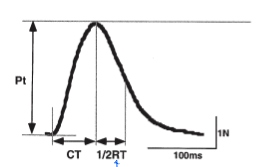
½ RT (half relaxation time)
time it takes for force to drop to half of its peak force
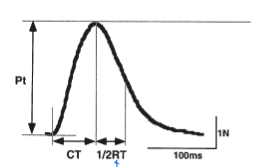
2-3 times stronger
how much stronger FF are than FFR
50% as strong
how strong S motor units are compared to FFR
2x as long
twitch contraction time of S compared to FF
example showing the vast differences across motor unit types in diffeerent muscles
type FF in diaphragm has a TCT of 34 ms
type S in peroneus longus has a mean TCT of 30.9 ms
generally proportional
relation of size of neuron to the number of fibers innervated by an alpha motor unit
FF > FFR > S (generally)
general schema of number of muscle fibers innervated by the different motor unit types
recruitment (number of units firing) and rate coding (discharge frequency of the motor unit)
two factors that modulate force in skeletal muscle, can be done expirementally by applying electrical stimulation
size principle
smaller motor units tend to be activated first and subsequent units were recruited in order of increasing size (Henneman’s, holds true for S motor units)
Fast motor units
motor unit type that doesn’t necessarily follow the size principle
recruitment of fast motor units
tend to be recruited in order of increasing force, not necessarily size
conduction velocity
technique that Henneman used in order to extrapolate the size of the alpha motor neuron tested in his size principle experiments
rate coding
aka discharge frequency, temporal summation in order to increase force of a muscle contraction (increase of frequency of firing)
MU are recruited and derecruited in order- the first ones on are the last ones off
interesting fact about recruitment and derecruitment
force frequency relationship
as the frequency of stimulus increases, so does the force generated- seen at the level of the muscle fiber, motor unit, whole muscle
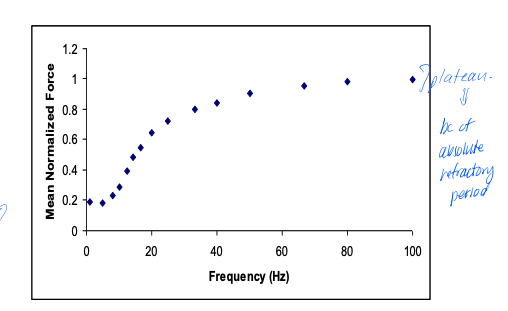
Ca2+
interaction of the force frequency relationship and excitation contraction coupling interaction can be seen through behavior of contraction in the reduction of this ion at low frequencies
greater effect
reduction of Ca2+ release has what kind of effect at low frequencies because our bodies operate at a lower frequency of about 30Hz and according to graph a small change in Ca2+ will result in a greater drop in force
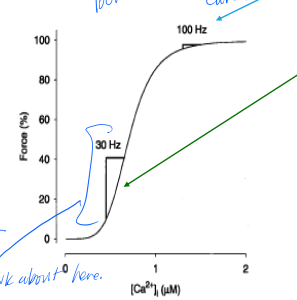
less effect
reduction of Ca2+ release has what kind of effect on force generation at high frequencies
greater Ca release (less at lower intensities)
calcium release behavior when there is greater intensity stimulus
decreased maximum and mean discharge rates
things that may worsen force reduction caused by decreased calcium release
histochemical technique in identifying fiber types
based on the pH lability of myosin ATPases, resulted in 2 divisions Type I and Type II, correlated to slow and fast fibers, newer refinement has ID up to 7 recognized human fiber (some may be hydrid)
basic pH
pH which resulted in stronger staining of fast muscle fibers (Type II)
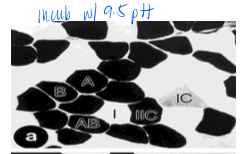
acidic pH
pH which resulted in stronger staining of slow muscle fibers (Type I)
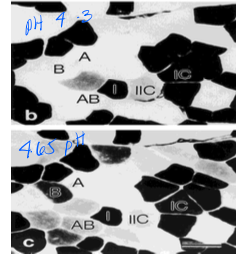
biochemical technique in identifying fiber type
activity of specific enzymes associated with metabolic process can be used to classify the fibers- can ID when combined with contractile properties as SO, FOG, or FG using citrate synthase, lactose dehydrogenase, SDH, GPDH, or glycogen content
current method of classifying fiber types
done by targeting spefic antibodies to different myosis heavy chain isoforms, groups fibers into 3 main groups- Type I, Type IIa, Type IIx
hybrid fibers
multiple (usually 2) MHC isoforms expressed in a fiber, often seen in transitions like detraining, training, or bedrest
Type IIb
NOT found in humans
characteristics of Slow (I) muscle fibers
low myosin ATPase activity and glycogen content, anaerobic enzymes; high fatigue resistance, oxidative capacity, myoglobin content; small fiber diameter; many capillaries, mitochondria; slow speed of contraction
characteristics of fast (IIa) muscle fibers
high mysoin ATPase activity, oxidative capacity, myoglobin content; fast speed of contraction; many mitochondria and capillaries; intermediate fatigue resistance, anaerobic enzymes, glycogen content
characteristics of fast (IIx) muscle fibers
high myosin ATPase acitvity, anaerobic enzymes, glycogen content; fast speed of contraction, low fatigue resistance, oxidative capacity, myoglobin content; few mitochondria, capillaries; fast speed of contraction
muscle spindle
essentially a sensory mechanoreceptor within the muscle, housed within the extrafusal fibers (typical myofibers of the muscle), contains intrafusal fibers that is innervated by the Ia/II afferent nerve fibers which send signals back to the spinal cord and responds to the stretch via the gamma motor neuron to contract the muscle
gamma motor neuron
aka fusimotor neurons, cell bodies in motor pools interspersed with alpha MNs, controlled from above by CNS, not impacted by spinal nerves, project to intrafusal fibers of the muscle spindle, cause contraction of the polar ends of spindles
alpha motor neuron
lower motor neurons in ventral horn of spinal cord, innervates extrafusal skeletal muscles, voluntary movement
alpha-gamma co-activation
normal movement and posture involves co-activation of these, as Ia afferent activity is required to enable max motor unit discharge rates during voluntary contraction, the tension on muscle spindle maintained as muscle shortens through activation of gamma afferent nerves as the alpha motor nerve fires, sensitivity of muscle spindle to stretch is maintained
golgi tendon organs
infor on tension is transmitted through IIb afferents, reflex inhibition of antagonist alpha motor neurons at spinal level, no motor innervation
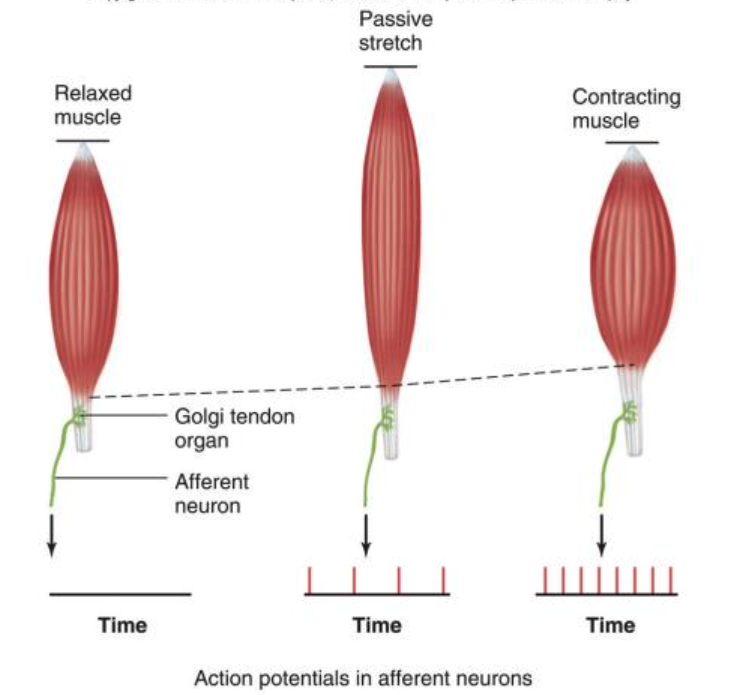
GTOs and spindles
muscles sensors that also provide signals to the brain to factor into motor control
the number of strongly bound crossbridges and physiological cross sectional area
what force is a function of
in parallel
stronger muscles will have more sarcomeres in this pattern
in series
higher velocity muscles will have more sarcomeres in this pattern
physiological cross sectional area
accounts for pennation angle of muscle, CSA x cos(pennation angle), typically lose some force generating ability per fiber but we are able to fit more fibers in when they are pennated so altogether we are able to produce more force
lowest/unloaded
velocity of shortening is the fastest when load is what
force-velocity curve
muscle maximally activated then allowed to shorten, because longer muscles have more sarcomeres in series they shorten at a greater rate
when extends into the eccentric range- negative shortening velocity
note higher forces vs shortening or even isometric
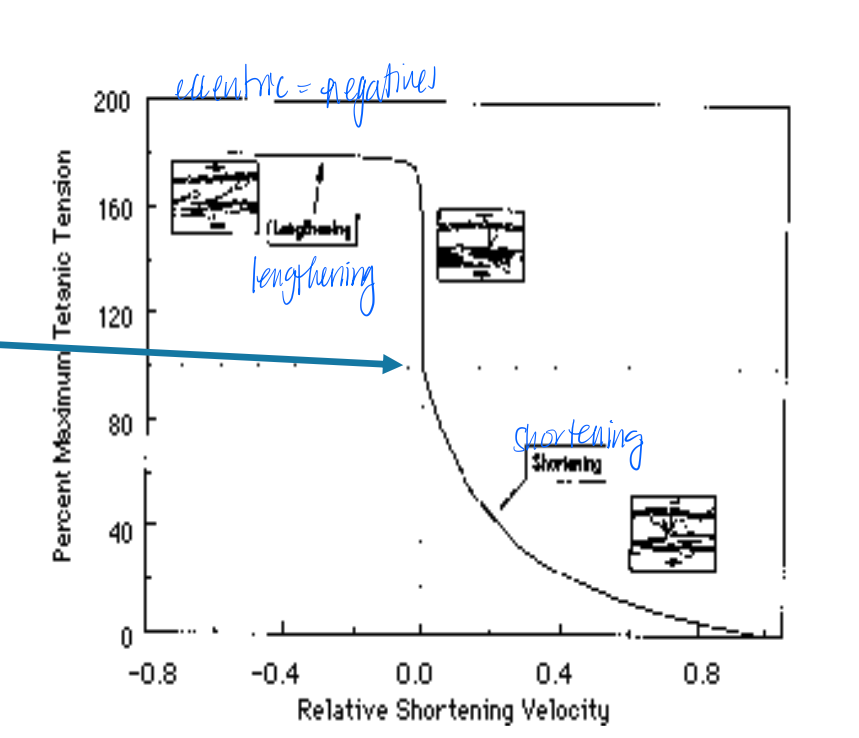
lower cross sectional area
green muscle line indicates this amount of cross sectional areal compared to the red muscle line (since its generates less force and they move through the same ROM)
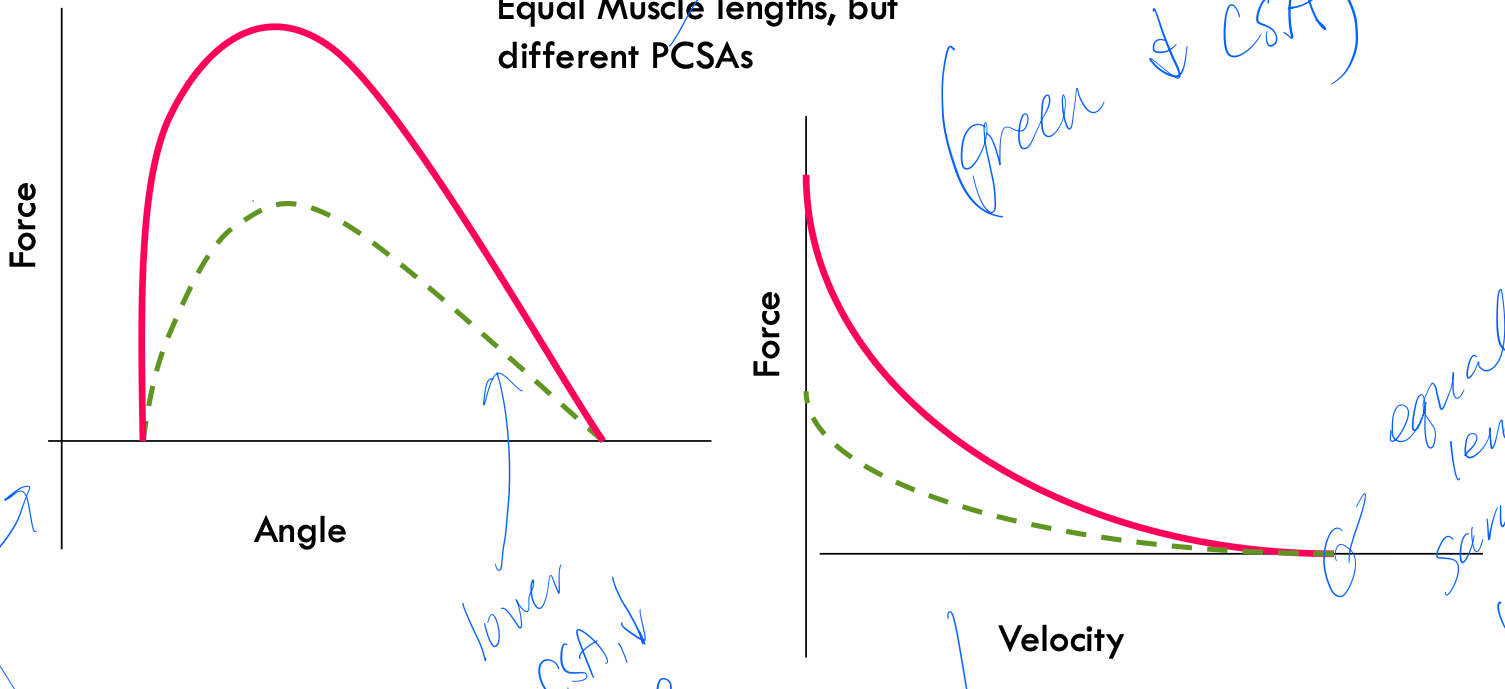
more sarcomeres in series
orange line muscle has how many sarcomeres in series as compared to the black line muscle (but equal PCSA bc generate the same force)
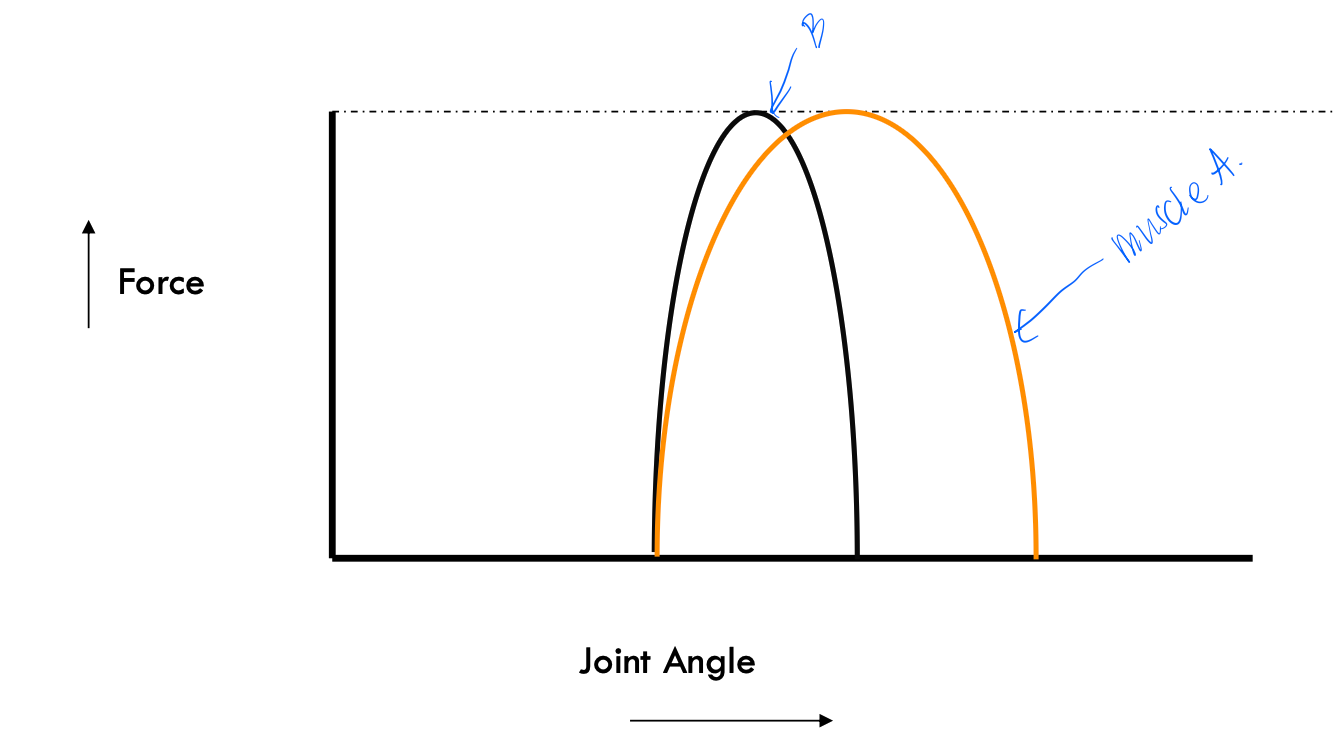
both force and velocity
what power is a function of, factors affectign one will impact power, changes in both will have an additive effect
power
perhaps the most functional parameter of muscle, ability to do generate force rapidly, often more important than absolute maximum force/torque production
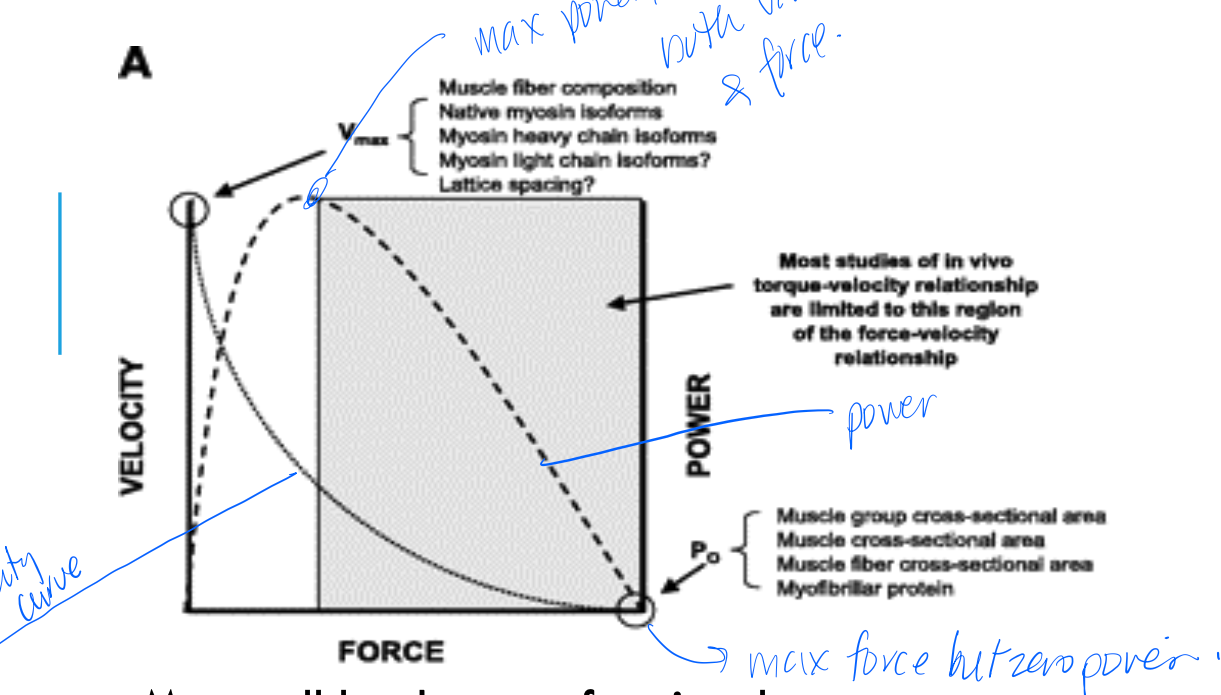
whole body mechanics
factors that contribute to this are at the fiber level (length-tension and force-velocity), multiple motor units (force frequency, recruitment and rate coding, contractile properties), connective tissue components (intramuscular, fascia, tendon which all add passive tension), moving in space
mechanisms affecting muscle force can act at any of these sites
neural sites: cortical excitability, spinal excitability, maximal motor unit discharge, nerve conduction
intramuscular sites: muscle architecture, muscle mass, increased myocellular lipid content, excitation contraction coupling
so many areas where things can go wrong, not just at the muscular mass level!
isometric contraction
contraction that results in constant length, more metabolically demanding that eccentric but less so than concentric
dynamic isotonic contractions
constant tension- against a weight
will result in change in muscle length or joint angle
eccentric and concentric are types
concentric contraction
most metabolically demanding contraction, constant tension that results in muscle or joint angle shortening
eccentric contraction
least metabolically demanding contraction, constant tension that results in muscle or joint angle lengthening, may be able to generate greater amounts of force due to gravity assistance, stored elastic energy, and passive tension, deceleration, less metabolically demanding (physically breaking crossbridges instead of using ATP to do so)
dynamic isokinetic contraction
constant velocity, requires special equipment, few functional occurrences, can be performed concentrically or eccentrically (usually concentric)
joint angle (affectign angle of force application and lever arm and muscle length), visco-elestic properties, angle of force application
factors that effect deviation from the classical length tension curves, or force and power predicitons, as muscles don’t work in isolation as is normally tested experimentally (and was confirmed in the intact gracilis muscle date from Lieber and Binder Markey)